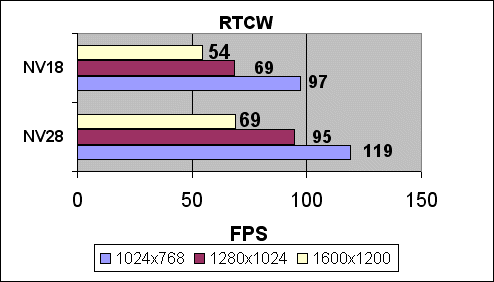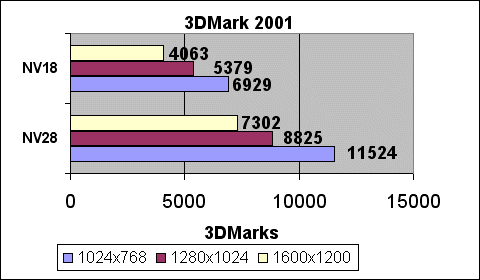Introduction
Let’s make this perfectly clear upfront: The new releases from NVIDIA are not their response to ATi’s Radeon 9700. They aren’t even completely new products. Instead, the NV18 and NV28 are incremental updates to the current GeForce4 MX and GeForce4 Ti products. The new iterations incorporate Intel’s latest AGP specification, 3.0 (read here for more information from Intel). The marketing name for the new spec is AGP 8X.
The Accelerated Graphics Port (AGP) was a stellar concept developed by Intel to permit video adapters to access system memory for use in video processing. This was a stellar idea in the mid-90s due to the very high price of RAM. Limiting RAM needed on the video card essentially reduces the cost necessary to produce the video card. Unfortunately, RAM prices dropped considerably as our Taiwanese friends more or less perfected the memory production process, giving us ever cheaper RAM prices. The need for off card memory has decreased with common video cards possessing no less than 32MB, and cutting edge cards having 128MB of RAM. AGP is used more for it’s faster access to the PCI bus, which is still needed to pass data from the CPU to the video adapter. Intel’s latest AGP specification is version 3.0. What’s new in this version is the addition of AGP X. AGP 8X doubles the graphics bandwidth of the AGP interface to 2.1 gigabytes per second. The Ti and MX GPUs are mostly unchanged other than the addition of the AGP 8X interface. However, the NV18 card we recieved did have a slightly higher core/memory clock speed than the AGP 4X versions. In addition to the GPUs, NVIDIA’s nForce2 platform processor also gets a kick in the AGP pants. NVIDIA made the change in anticipation of bandwidth-hungry applications coming in the near future (which translates to DOOM III in our book). A secondary and significant benefit of this new specification is the requirement for 0.8V signal scheme for the AGP port in both AGP 4x and 8x. This is a huge drop form the high demand of AGP 1x and 2x which was 3.3V. If you recall, there were problems early on in several motherboard manufacturer’s products with AGP signal strength where some highly demanding video cards had problems getting enough power from the AGP ports. This new specification relieves some of the burden from the motherboard. The following list summarizes the significant (and of interest to the average reader) revisions to the AGP2.0 specification:
- AGP 8x mode added for a max transfer rate of 533 megatexels per second. It remains att the 66 MHz frequency.
- The edge connector of the existing AGP spec is the same, however the signaling scheme has been modified to ensure the low voltage specification which determines whether the voltage should switch from 0V (essentially and off state) to 0.8V. The 66MHz clock and reset signals do remain at 3.3V, however.
- The GART (Graphics Address Re-map Table), which is the responsibility of the video cards software drivers, must enforce hardware (physical memory on the motherboard that the video is using) cache coherency. This in effect, forces the physical memory sections being used by the video card to remain open and ready for use.
- The AGP2.0 specification classifies memory transactions are high priority read or low priority rite transactions. The AGP3.0 spec. removes the classifications and treats all transactions as equal.
- AGP3.0 requires the use of Side Band Addressing for AGP transactions. The older PIPE transaction method can no longer be used. SBA is better, to be brief.
-
Isochronous transactions are now supported. Here’s the benefits of AGP 8X according to NVIDIA: “AGP 8X enables more complex models and detailed textures, creating richer and more lifelike environments. Uninterrupted data flow allows for smoother video streaming and faster, more seamless gameplay.” Gameplay is pretty easy to figure out. Advancing game graphics will require greater and larger textures. The bigger the pipeline, the better the throughput. What about video? According to NVIDIA, AGP 8X introduces an isochronous operation mode. Isochronous transport means data (video streams, in this case) is delivered as fast as it is displayed and that the audio is synchronized with the video.
- Multiple AGP ports are now supported! Multiple ports and multiple devices on each port are now supported by AGP3.0. Anybody for dual NV28s?
What this new AGP3.0 specification means to us, the end users:
As you’ll note on the many NV18 & NV28 reviews on the net, AGP8x offers very little performance advantage to users with late model systems and high performance video cards because little system memory usage is needed by these 128MB cards. Where it WOULD show a marked improvement is in video cards with little memory (<32MB) that have to utilize the system memory under late model games. Unfortunately, what are the chances of Geforce2 MXs being manufactured under the AGP 8x spec? This type of card, IMO, would likely see a marked improvement in performance.
A big downside of this new AGP3.0 specification is that it won’t support the old AGP 1x and AG 2x 3.3v specification. This is likely not a big issue since there will be practically no Rendition V1000 and V2220 users who would run these cards on an AGP3.0 spec motherboard, but this is a real issue. However, chipset designers could choose to leave in the older 3.3v AGP specification.
The motivation for adding 8X support doesn’t really lie in the enthusiast market, oddly enough. OEM’s need the 8X buzzword in their product offerings because Intel is starting to pimp it as another must-have technology. Which is why NIVIDIA is just offering 8X in the MX and Ti 4200 products; they’re the ones most likely to end up in a mass market PC.
NV18 and NV28 Specifications
Our test mules are reference boards from NVIDIA. Here are the side-by-side specifications per NVIDIA:
| GeForce4 MX 440 | GeForce4 MX 440 w/ AGP 8X | ||
| Fill Rate: |
1.1 Billion Texels/Sec. | Fill Rate: |
1.1 Billion Texels/Sec. |
| Triangles per Second: | 34 Million | Triangles per Second: | 34 Million |
| Memory Bandwidth: | 6.4GB/Sec. | Memory Bandwidth: | 8.0GB/Sec. |
| Memory: | 64MB |
Memory: | 64MB |
| Core/Memory Clock Speeds | 270/400MHz | Core/Memory Clock Speeds | 275/513MHz |
| GeForce4 Ti 4200 | GeForce4 Ti 4200 w/ AGP 8X | ||
| Vertices per Second: |
113 Million | Vertices per Second: |
113 Million |
| Fill Rate: | 4 Billion AA Samples/Sec. |
Fill Rate: | 4 Billion AA Samples/Sec. |
| Operations per Second: | 1.03 Trillion | Operations per Second: | 1.03 Trillion |
| Memory Bandwidth: | up to 8GB/Sec. | Memory Bandwidth: | 8GB/Sec. |
| Memory: | 128MB |
Memory: | 128MB |
| Core/Memory Clock Speeds | 250/500MHz | Core/Memory Clock Speeds | 250/500MHz |
The 440MX gets a nice little speed boost in its core and memory, but the Ti 4200 is unchanged other than the switch to the AGP 8X bus.
Testing
Test system
We celebrated the new silicon with a test bed of brand new components:
- CPU: AMD 2700+
- Motherboard: ASUS A7N8X nForce 2 (Pre-Production)
- Memory 512MB 2x Corsair 3200 CAS2 DDDR
- Hard Drive: Western Digital 120GB SE
- OS: Windows XP SP1
- Video Drivers: NVIDIA Reference 40.71 (beta)
Benchmarks
The numbers below are from our test system. They are shown to give you an idea of the performance capabilities of the MX 440 and Ti 4200.
Quake III Arena
Return To Castle Wolfenstein
3DMark 2001
Unfortunately, we were unable to test ‘old’ cards in a side-by-side comparison between AGP 4X and 8X (due to shipping time constraints). As has been shown by other sites’ investigations into AGP 8x, the performance increase is typically in the 3-5% range for current generation video cards. The scores shown above appear to be inline with that estimate, when compared to our recent GF4 MX and GF4 Ti reviews although the NV18 scores are likely somewhat higher due to the faster core/memory speed on our reference board as well. Production boards may end up being clocked higher as well.
Conclusions
It’s apparent that AGP 8X doesn’t offer much of improvement for today’s applications. The AGP 4X bus is more than sufficient for current workloads, considering that minimal system cacheing is taking place on 128MB video cards. The MX 440 does benefit somewhat from its speed boost, but enthusiasts need to keep in mind that the MX line does not support advanced DirectX 8 features. The Ti 4200 is still an excellent card for the money, and the addition of AGP 8X certainly doesn’t hurt it any. So, the bottom line is there is no need to rush out and buy an AGP 8X card today. However, AGP 8x and Intel’s AGP3.0 spec. include some handy revisions like lower power requirements, multiple AGP port capability; and we’re certain NVIDIA will continue to provide leading edge AGP 8x products to support this new platform.
 Bjorn3D.com Bjorn3d.com – Satisfying Your Daily Tech Cravings Since 1996
Bjorn3D.com Bjorn3d.com – Satisfying Your Daily Tech Cravings Since 1996






